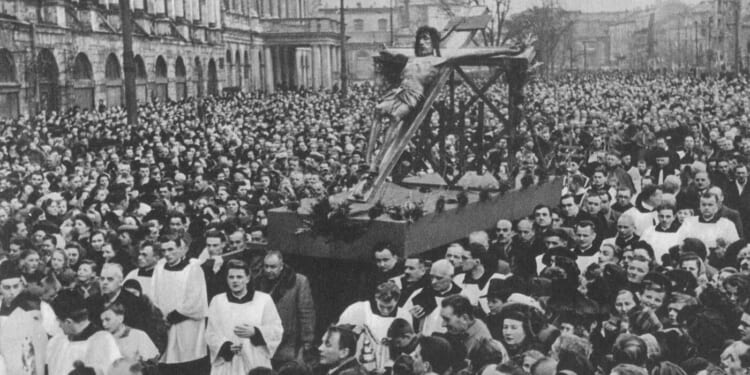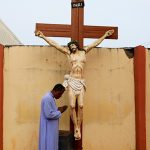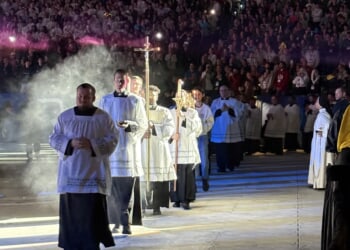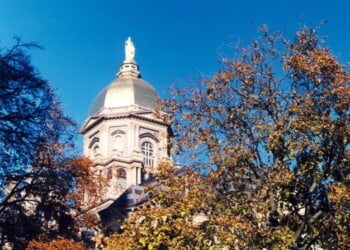Upon the Cross, Christ wrought our reconciliation with God. This grace of reconciliation, inseparably united to forgiveness, is meant to flow into our own lives—softening even the most testing relations with those nearest to us, shaping the bonds within our local communities and places of work, and extending, by God’s mercy, to the healing of divisions between estranged peoples and nations.
In 1525, Jerzy Baryczka, a wealthy Warsaw merchant and alderman on his way back from Nuremberg, brought with him a Gothic crucifix of exceptional beauty to present to what is now St. John’s Archcathedral in Warsaw, Poland. The figure of Christ is life-sized, with real hair and a crown of thorns fashioned from blackthorn. His eyes are closed, his face gaunt, his cheeks sunken; the sculptor has captured the moment just after death. The statue was executed in accordance with medieval descriptions of Christ’s passion and death.
Never in a million years did the maker imagine that, across centuries, children and the elderly, townsfolk and peasants, nobles and princes, priests and bishops, deputies and senators, kings and presidents—even two canonized metropolitans and two popes: Benedict XVI and St. John Paul II—would all bend the knee before this precious crucifix!
From its very beginnings, the Baryczka Crucifix stood as an object of veneration and pilgrimage for countless faithful, calling them to prayer and forgiveness. It remained in a side altar until 1602, when a hurricane brought down the Church’s soaring spire and crushed the entire left nave beneath a cascade of falling masonry. Still, the Crucifix emerged unscathed, a survival that only deepened Warsaw’s belief in its miraculous power.
Furthermore, the endurance of the wooden sculpture through the cataclysm of the Swedish Deluge (1655-1660)—an onslaught that spared none of the city’s churches—must be deemed nothing short of extraordinary. Likewise, it also weathered the long years of partitions, wars, and calamities, as well as the November Uprising of 1830 and the January Uprising of 1863. In short, the Crucifix has repeatedly proved to be a beacon of steadfastness against all odds!
In the 19th century, the Cathedral’s interior underwent further transformations, including a remodelling in the English Gothic style, but neither did this hinder the ever-growing devotion it continued to inspire.
From the Crucifix’s rich and checkered history, perhaps the most dramatic episode belongs to a later day—the Warsaw Uprising of 1944. Here is an excerpt from the diary of Barbara Gancarczyk-Piotrowska, a nurse with the 2nd Platoon of the Home Army battalion:
I remember 16 August most vividly, for that was when the Cathedral caught fire. There was nobody inside at the time; our posts had been abandoned, and our fellow fighters had withdrawn as the great blaze took hold, spreading with terrifying speed. At one point I found myself in the Cathedral with my friend Teresa Potulicka-Łatyńska. Through the smoke we glimpsed a Priest standing on the altar in the Baryczka Chapel, trying to lift down the Crucifix of Our Lord. Years later I learned that he was Father Wacław Karłowicz, who operated [in the Polish Underground] under the pseudonym “Andrzej Bobola.” No one else was with him so we ran up to help. In the end he managed to remove the figure himself and handed it to us. We carried it through a narrow passage beside the sacristy and then had to go out into Jezuicka Street. There Father laid the figure onto the cobblestones and detached its arms from the body so that he could carry it further through the cellars. Those cellars were horrendously crowded. I walked in front, holding the figure’s arms before me while conveying to the people that we were carrying the statue of the Miraculous Christ. They all moved aside, they knelt, prayed, wept.
The figure was first taken to the chapel of the Sisters of Charity, and then a few days later Fr. Karłowicz carried it to the field hospital in the cellars of St. Hyacinth’s Church, laying it among the wounded insurgents. There, in the gloom of the vaults, Fr. H. Cybulski—administering the Last Rites to dying fighters—mistook the recumbent figure of Christ for one of the wounded and anointed it with the Holy Oils. This poignant incident was later woven by a film director—Andrzej Wajda—into his film Katyń.
When the Nazis came and seized that part of the New Town, they executed or burned alive all the hospital staff and blew up the church cellars with all the wounded still inside. About 500 people perished beneath the rubble. Among them lay the figure of Christ from the Baryczka Chapel. Mistaken by the Germans for the body of an insurgent, it escaped being looted.
On Palm Sunday of 1948, the Crucifix returned to the ruined Cathedral of St. John and was once again placed in the surviving Baryczka Chapel, a silent witness to the power of faith that forgives, endures, and overcomes. In a solemn procession led by the Cardinal Primate August Hlond, countless survivors of Warsaw’s wartime cataclysm gathered to welcome it back. This was also a symbolic act of seeing the relic restored to the capital after the great strength and hope it had given the people on the eve of the impending dark night of Stalinism.
This year, the entire calendar is filled with festivities marking the 500th anniversary of the arrival of the “Miraculous Crucifix” in Warsaw. The Jubilee was inaugurated with a solemn Mass attended by the Polish Bishops’ Conference. Bishop Michał Janocha wrote:
As a work of art, it is an artistic miracle. Its survival in a city condemned to non-existence (by the Germans) is a historical miracle. The uninterrupted veneration spanning over five centuries, most of which is recorded, as well as all the personal encounters of grace which cannot be told, are indeed a theological miracle.
As in days of old, the worshippers still kneel to implore forgiveness for their sins, to plead for help, and to give thanks for the graces received before the Miraculous Crucifix. From Monday to Saturday, Holy Mass is celebrated at 7 a.m. and 8 a.m. There are two confessionals, and in one of them a priest is always present, so that the faithful may be reconciled with God.
When you stand to pray, forgive anyone against whom you have a grievance, so that your heavenly Father may in turn forgive you your transgressions. (Mk. 11:25)
Every cross bearing the image of Jesus leads our thoughts back to the Cross on Calvary, where our Saviour suffered and died. And upon that Cross Christ uttered the momentous words: “Father, forgive them, for they know not what they do” (Lk. 23:34).
Our Lord teaches us to seek forgiveness “as we, in turn, forgive.” He makes it unmistakably clear that if we fail to forgive others, we ourselves shall not be forgiven. This truth should stir us profoundly, moving us to strive with all our strength to forgive others completely, from the depths of our hearts. These words remind us that each of us is a sinner, and that before God we bear an incalculable, unpayable debt of guilt. Only humble supplication for pardon and for Divine Mercy can atone for the evil that humanity has sown between itself and its Creator.
Daily participation in the Holy Mass, Eucharistic Adoration, and the prayer of the Holy Rosary are all powerful weapons that quiet unruly emotions. They open the heart to God’s peace, patience, and even kindness toward those who offend. Often it helps to see the wrongdoer as one caught in spiritual bondage, unable by himself to escape the clutches of sin.
May the story of the miraculous Baryczka Crucifix awaken in us the desire for unconditional forgiveness.
Image from Wikimedia Commons















